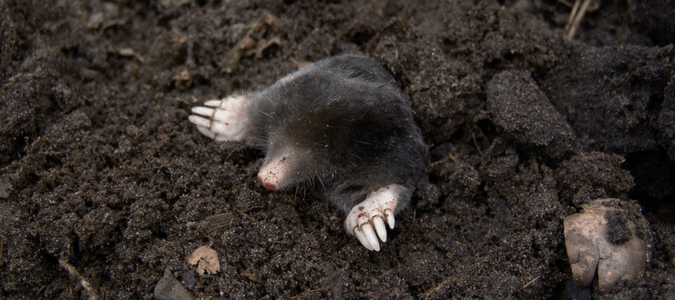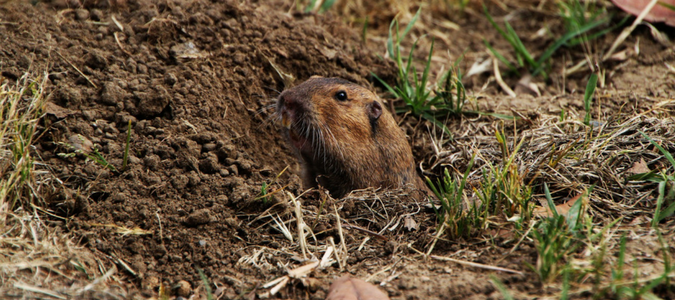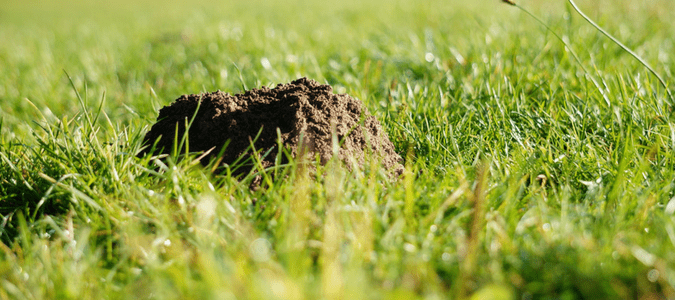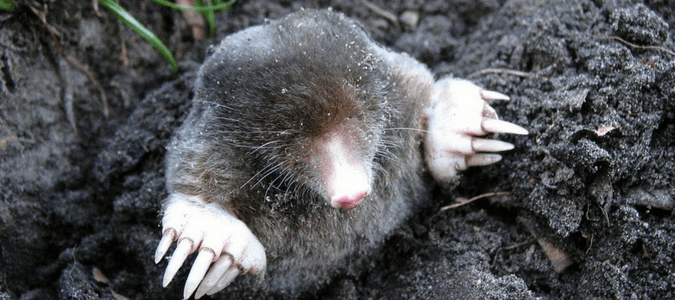
Knowing what you’re dealing with can be hard when something burrows in your yard. Those mounds of dirt can seemingly pop up overnight, displacing plants and flowers or creating ugly tunnels. One of the possible culprits for this type of lawn damage is a mole. What kinds of moles live in Texas, and what should homeowners know about these creatures? In this post, we’ll tell you everything you need to know about these animals, including how to discourage them from making your property their home.
Moles in Texas: How To Control This Lawn Pest
Knowing the difference between gophers, moles, and voles and which is damaging your lawn helps determine the best course of action. All three burrow underground but differ in appearance and diet. When any of these animals reside on a golf course or another large tract of land, it can be tough to eradicate them. When they are under your lawn or garden, however, you can take steps to remove them and discourage them from coming back.
Knowing it is a mole wreaking havoc in your yard is the first step in getting rid of these pests for good. To better understand how to do your mole control, you’ll also need to know what attracts moles to your yard first, the damage they can do, and warning signs that they have arrived. Most importantly, we’ll give you some ideas on removing them and keeping them away from our property.

Texas Gopher
Before we discuss the mole in more detail, let’s talk about some other animals with similar habitats and behaviors. One animal which can cause similar damage to your yard is a gopher. The Texas gopher species you will run across the most often is one of the pocket gopher species, ranging from five to fourteen inches long. These small brown-colored rodents, which can weigh up to a pound, primarily eat fleshy roots of plants, but also like tubers such as potatoes and peanuts. Although gophers have poor eyesight, their other senses, such as their sense of smell, are more developed, so gophers usually hide before you see them.
Gophers have four long yellow incisor teeth that look similar to guinea pig. They reproduce twice a year with an average of two offspring for each birth. Gophers only live about a year or two.
There are a few critical differences between gophers and moles. The two animals differ in appearance, and gopher mounds tend to be flat and spread out, whereas mole mounds are volcano-shaped. Although both animals can burrow to find food, gophers eat vegetation and roots, while moles feast on grubs and earthworms. Damage from gophers can be more significant than moles and is sometimes not detected until the affected plants or trees die.
Voles
Like gophers, voles, known as meadows or field mice, tunnel underground and feed on plants and vegetation; Mexican voles, prairie voles, and woodland voles are the species found in Texas. These rodents are also covered in brown or black fur and are up to five inches long. These guys only live two to 16 months but breed constantly and can have one to five litters each year, producing between three to six babies.
Damage from voles looks like damage from mice and rats: gnawing on trees and plant roots, tunneling underneath lawns, and tearing up mulch in flowerbeds. Voles don’t leave mounds like moles, and damage tends to be less significant since they are smaller animals.

Eastern Mole Facts
The Eastern mole is the most common species in Texas (in fact, it’s also known as the common mole) and can be harder to control than gophers. Eastern moles prefer moist, sandy soil and avoid dry sands and heavy clays. Unlike gophers, moles are primarily carnivores, feeding on insects such as earthworms, grubs, beetles, spiders, and insect larvae. According to various sources, moles consume anywhere from 32 to 70 percent of their body weight per day.
These grayish-brown mammals weigh approximately four ounces as adults and can grow up to seven inches. They have a furless pointed snout, small eyes hidden in their fur, and flesh-colored broad front feet with claws. Moles can live up to three years and tend to be more solitary than gophers.
Moles are most active on cloudy days in the spring and fall. They have few natural enemies because of their subterranean status, but they must watch out for coyotes, dogs, cats, badgers, and skunks. Indeed the biggest threat to moles’ survival is flooding.
Eastern Mole Baby
Eastern moles carry their babies for 42 days and have three to five young per year, born in March and early April. It takes an Eastern mole baby about 14 days to grow hair and one month to wean. Afterward, they leave the nest to make tunnel systems in someone else’s yard.
During late winter and early spring, male moles extend their tunnels to cover more territory during the breeding season. This is also when moles can sometimes be seen traveling above the ground, searching for that lucky female.

Moles in Texas Yards
Unlike gophers and voles, moles cause damage to yards through their search for insects. Damage to yards and plants occurs when moles push up through the ground and tunnel underneath.
The tunnels are usually less than two inches in diameter and can be 16 to 18 inches below ground. Mole pathways consist of subsurface (access roads and surface streets) and deeper runways (highways). They use the subsurface tunnels, seen above ground, as feeding tunnels. The deeper tunnels are used to travel between the nest and subsurface tunnels. Both types of tunnels are created by moles doing the backstroke and making lateral thrusts with their front feet. According to the Natural Science Research Laboratory at Texas Tech University, one burrow along a fence row in Van Zandt County was 360 meters long—almost a quarter of a mile!
Despite tearing up your yard, moles can provide some benefits. They actually aerate the soil as they tunnel through your yard, loosening the soil and mixing deeper soils with the surface organic material, enhancing soil quality overall.
Another benefit to having moles is that they eat insect larvae, which can be harmful to your sod and plants. Larval June beetles feed on grass roots which can kill your sodded yard. The small mammals also attack underground yellow jacket nests and resting areas for other wasps.
Signs of Moles In Yard
Since moles usually are hidden underground in their tunnels, you rarely see one. However, there are things to look for to determine if you may have a mole problem:
- Molehills, which can look like anthills, are usually the biggest indication. Like ants, as they tunnel, they get rid of the dirt. Moles are most active during the day. The mounds for the deeper tunnels or the runway mazes for the subsurface tunnels can seemingly spring up in a single day.
- Tunnels, which look like lines through your yard, can sometimes be seen, even though they are underground.
- Dead plants or grass can indicate if moles’ burrowing activity pushes the plants or grass up, damaging root systems.
Mole Deterrents
Even if moles can do your aerating for you, many homeowners would prefer they stay on the golf course instead of in your grass. There are a variety of things you can do to reduce your risk of a mole infestation. Some suggestions to discourage moles from hanging out in your yard include:
- Reducing moisture in the soil can help rid the area of unwanted moles since the grubs and earthworms that moles are searching for in your soil are drawn to wet conditions.
- Using insecticides to kill a mole’s natural food source can deter them from residence in your yard. One downside of this approach is that earthworms are suitable for your yard, so getting rid of earthworms may do more harm than good. You may also risk making the mole damage worse as these burrowing creatures continue to search for food before leaving the area.
- Installing garden barriers planted to a depth of 12 inches can prevent moles from tunneling into your yard or garden.

How To Get Rid of Moles
Before you play whack-a-mole in real life, you can try several DIY methods to remove moles from your property. Some of the more common methods include live capture, cultural control, and repellents.
Live Capture
The most straightforward method to remove these animals from your yard is to trap them and humanely relocate them elsewhere. The best way to do this is to dig a hole and place 3-pound coffee cans under and even with an active runway to lure the moles in. Wear gloves so that you don’t leave your scent behind. If you skip this step, the moles will avoid the area.
Cultural Control
As described above, you can plant aluminum sheeting or ¼-inch mesh galvanized hardware cloth to a depth of 12-30 inches while allowing for six inches above the ground to prevent moles from tunneling into your yard or garden.
Repellents
Some homeowners use castor bean oil-based repellents to keep moles away. These are often expensive, however, and need to be reapplied after heavy rain. Other more potent insecticides exist, some only available to commercial pest control companies. Some homeowners attempt fumigation, but this method is not always successful and can pose other risks to wildlife in your yard.
ABC Can Help You Get Rid of Moles
One of the reasons getting rid of moles and other burrowing creatures is so tricky is that these animals are masters at hiding and digging and spend most of their time underground. Trapping and special repellents are some of the most successful methods of removing these destructive creatures, but many homeowners find these techniques more complex and less successful than they hope. The pest control experts at ABC Home & Commercial Services have decades of experience working to rid Texas homes and yards of any pests. Homeowners can schedule a time to inspect their homes, assess their problems and recommend solutions. With ABC’s help, you won’t have to worry about moles or any other creatures ruining all the hard work you have put into your yard or garden.